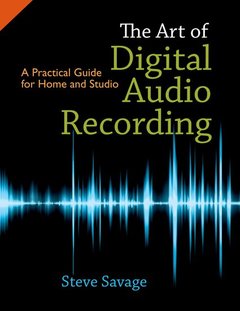Description
The Art of Digital Audio Recording
A Practical Guide for Home and Studio
Author: Savage Steve
Language: English
The art of digital audio recording: a practical guide for home and studio (paperback)
Publication date: 06-2011
288 p. · 27.7x21.6 cm · Hardback
Publication date: 06-2011
288 p. · 27.7x21.6 cm · Hardback
The art of digital audio recording: a practical guide for home and studio (hardback)
Publication date: 06-2011
288 p. · 27.9x21.8 cm · Paperback
Publication date: 06-2011
288 p. · 27.9x21.8 cm · Paperback
Description
/li>Contents
/li>Biography
/li>
Making great audio recordings requires striking the right balance between technical know-how and practical understanding of recording sessions. Even in the digital age, some of the most important aspects of creating and recording music are non-technical and, as a result, are often overlooked by traditional recording manuals. The Art of Digital Audio Recording teaches readers what they really need to know in order to make great sound recordings with computers - both the practical and the technical information, including: BL What to look and listen for in a recording environment BL Straightforward advice on recording almost any instrument BL Essentials of digital audio workstations BL Essentials of recording gear: microphones, mixers, and speakers BL Fundamentals of understanding and applying EQ, compression, delay, and reverb BL Secrets to running creative recording sessions BL Practical application of digital editing, mixing, and mastering A special section identifies solutions to the most common challenges in the recording studio, and the book also features an addendum with essential tips and reference information including: BL How to walk into a commercial studio and be the engineer BL Researching and buying gear: Internet vs. brick and mortar BL Digital formats: A handy reference As a whole, The Art of Digital Audio Recording is an essential resource that gives recordists the tools they need to let technical understanding serve greater musical goals.
Introduction. 1. The Starting Point - Sound meets the computer. 1. Why computers. 2. What does it sound like?. 3. Signal path. 2. The Essentials - Where and how recordings are made. 4. Recording rooms and control rooms. 5. Studio monitors. 6. Microphones and mic placement. 7. Mixing boards and control surfaces. 8. EQ: general information. 9. Dynamics (compressors and noise gates). 10. FX: delay. 11. FX: reverb. 12. Beyond traditional DSP. 3. Recording Sessions - A practical guide. 13. Set up. 14. Headphone mixes. 15. Survey of recording techniques for instruments and voice. 4. Editing - The new frontier. 16. Editing functions. 17. Screen "real estate". 18. Virtual tracks (playlists). 19. Advanced Editing. 5. Three Fundamentals - Techniques every recordist needs to know. 20. Insert/Plug-ins. 21. Send aamp, return. 22. Auto-switching (auto-input). 6. Mixing - The most creative and the most challenging stage. 23. Mixing requirements. 24. Building a mix. 25. Automation and recall. 26. Mix collaboration, communication and delivery. 7. Mastering - One last session. 27. What, Why, How and Where. 8. Three Best Practices - Easy ways to raise the level of your sessions. 28. Session flow. 29. Talkback. 30. Playback volume. Addendum:. 31. How to Walk into a Commercial Studio and be the Engineer. 32. Researching and Buying Gear: Internet vs. brick and mortar. Appendix:. Digital Audio Formats, Delivery and Storage. Index.
An active producer, recording engineer, and instructor, Steve Savage has been the primary engineer on seven Grammy-nominated CDs. He is the author of numerous books, including the forthcoming Bytes & Backbeats: Repurposing Audio in the Digital Age.
© 2024 LAVOISIER S.A.S.




